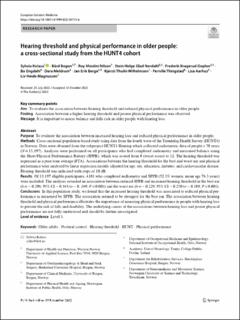| dc.contributor.author | Kolasa, Sylwia Katarzyna | |
| dc.contributor.author | Bogen, Bård Erik | |
| dc.contributor.author | Nilsen, Roy Miodini | |
| dc.contributor.author | Nordahl, Stein Helge Glad | |
| dc.contributor.author | Goplen, Frederik Kragerud | |
| dc.contributor.author | Engdahl, Bo Lars | |
| dc.contributor.author | Meldrum, Dara | |
| dc.contributor.author | Berge, Jan Erik | |
| dc.contributor.author | Wilhelmsen, Kjersti Thulin | |
| dc.contributor.author | Thingstad, Pernille | |
| dc.contributor.author | Aarhus, Lisa | |
| dc.contributor.author | Magnussen, Liv Heide | |
| dc.date.accessioned | 2023-05-04T08:05:47Z | |
| dc.date.available | 2023-05-04T08:05:47Z | |
| dc.date.created | 2022-11-28T12:34:02Z | |
| dc.date.issued | 2022 | |
| dc.identifier.citation | European Geriatric Medicine. 2022, . | |
| dc.identifier.issn | 1878-7649 | |
| dc.identifier.uri | https://hdl.handle.net/11250/3066105 | |
| dc.description.abstract | Purpose: To evaluate the association between increased hearing loss and reduced physical performance in older people. Methods: Cross-sectional population-based study using data from the fourth wave of the Trøndelag Health Survey (HUNT4) in Norway. Data were obtained from the subproject HUNT4 Hearing which collected audiometric data of people > 70 years (N = 13,197). Analyses were performed on all participants who had completed audiometry and measured balance using the Short Physical Performance Battery (SPPB), which was scored from 0 (worst score) to 12. The hearing threshold was expressed as a pure tone average (PTA). Associations between the hearing threshold for the best and worst ear and physical performance were analyzed by linear regression models adjusted for age, sex, education, diabetes, and cardiovascular disease. Hearing threshold was indicated with steps of 10 dB. Results: Of 13,197 eligible participants, 4101 who completed audiometry and SPPB (52.3% women. mean age 76.3 years) were included. The analyses revealed an association between reduced SPPB and increased hearing threshold in the best ear (b = − 0.296; 95% CI − 0.343 to − 0. 249; P < 0.001) and the worst ear (b = − 0.229; 95% CI − 0.270 to − 0.189; P < 0.001). Conclusions: In this population study, we found that the increased hearing threshold was associated to reduced physical performance as measured by SPPB. The association seemed to be strongest for the best ear. The association between hearing threshold and physical performance illustrates the importance of assessing physical performance in people with hearing loss to prevent the risk of falls and disability. The underlying causes of the associations between hearing loss and poorer physical performance are not fully understood and should be further investigated. Level of evidence: Level 3. | |
| dc.description.abstract | Hearing threshold and physical performance in older people: a cross-sectional study from the HUNT4 cohort | |
| dc.language.iso | eng | |
| dc.title | Hearing threshold and physical performance in older people: a cross-sectional study from the HUNT4 cohort | |
| dc.title.alternative | Hearing threshold and physical performance in older people: a cross-sectional study from the HUNT4 cohort | |
| dc.type | Peer reviewed | |
| dc.type | Journal article | |
| dc.description.version | publishedVersion | |
| dc.source.pagenumber | 8 | |
| dc.source.journal | European Geriatric Medicine | |
| dc.identifier.doi | 10.1007/s41999-022-00713-6 | |
| dc.identifier.cristin | 2082514 | |
| cristin.ispublished | true | |
| cristin.fulltext | original | |
| cristin.qualitycode | 1 | |
